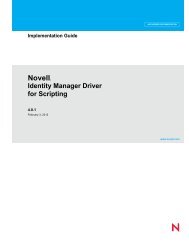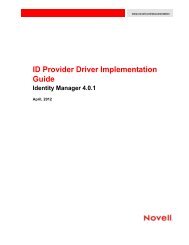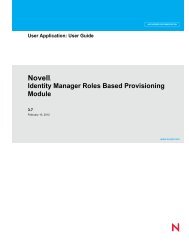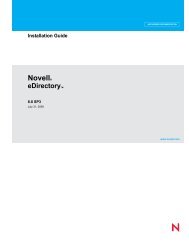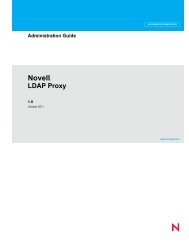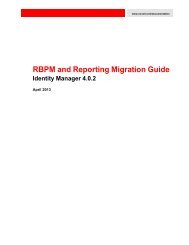Novell iManager 2.7.5 Administration Guide - NetIQ
Novell iManager 2.7.5 Administration Guide - NetIQ
Novell iManager 2.7.5 Administration Guide - NetIQ
Create successful ePaper yourself
Turn your PDF publications into a flip-book with our unique Google optimized e-Paper software.
6.4.5 Redirection After Logout<br />
The Redirection After Logout option allows you to specify the URL to be redirected to, after you log out<br />
of <strong>iManager</strong>. If you have not selected this option, when you click Exit, you are logged out of<br />
<strong>iManager</strong>. By default, the Login page is displayed.<br />
Enable: Select this option to enable Redirection After Logout feature.<br />
URL: Specify the URL to be redirected to, after you log out of <strong>iManager</strong>.<br />
6.4.6 Authentication<br />
The Authentication tab configures <strong>iManager</strong>’s login page. It contains the following options:<br />
Remember login credentials: When selected, users must only enter a password to log in.<br />
Use Secure LDAP for auto‐connection: When selected, <strong>iManager</strong> performs LDAP communications<br />
using SSL. Some plug‐ins, such as Dynamic Groups and NMAS, do not work if this option is not<br />
selected. This setting does not take effect until you log out of <strong>iManager</strong>.<br />
Hide specific reason for login failure: When selected, <strong>iManager</strong> replaces authentication‐related<br />
eDirectory messages with a generic error message that reads: Login Failure. Invalid Username<br />
or Password. For more information, see “Preventing User Name Discovery” on page 113.<br />
Allow ‘Tree’ selection on Login page: When selected, <strong>iManager</strong>’s login page displays the Tree field.<br />
If you do not select this option, you must have a default tree name specified or you cannot log in.<br />
Contextless Login: Contextless login allows users to log in with only user name and password,<br />
without knowing their entire User object context. For example, .admin.support.sales.novell.<br />
If there are multiple users with the same user name in the tree, contextless login allows to log in by<br />
using the first user account it finds with the supplied password within the container order list that<br />
the user has specified. User can re‐arrange and set the container order list.<br />
If there are multiple users with the same user name in the tree, to log in with a specific user name, a<br />
user should provide full context when logging in, or limit the search containers that contextless login<br />
searches.<br />
Select Search from Root to perform the user search from the root of the directory tree. Select Search<br />
Containers to specify one or more containers where User objects can be found.<br />
By default, <strong>iManager</strong> connects with public access, requiring no specific credentials. You can specify a<br />
user with specific credentials to do the search for the contextless lookup. The <strong>iManager</strong> public user is<br />
used if you don’t specify a user.<br />
IMPORTANT: If you specify a public user, consider carefully the implications of password<br />
expiration settings. If the password is set to expire for the public user, you do not have the<br />
opportunity to change the password during login after it expires.<br />
<strong>iManager</strong> Server Timeout Settings: If you want the <strong>iManager</strong> server to time out after a certain<br />
period, specify the number of days, hours, and minutes in the respective fields, in the Authentication<br />
page.<br />
If you never want the server to time out, select the Never Timeout option.<br />
72 <strong>Novell</strong> <strong>iManager</strong> <strong>2.7.5</strong> <strong>Administration</strong> <strong>Guide</strong>




